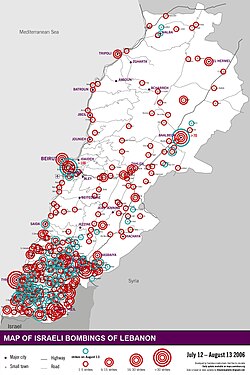| Revision as of 10:43, 7 February 2015 view sourceJohn of Reading (talk | contribs)Autopatrolled, Extended confirmed users, Pending changes reviewers767,601 editsm Typo/general fixing, replaced: it's authority → its authority using AWB← Previous edit | Revision as of 21:21, 13 July 2015 view source Onceinawhile (talk | contribs)Autopatrolled, Extended confirmed users, Pending changes reviewers49,722 edits removed Category:Southern Levant using HotCatNext edit → | ||
| Line 176: | Line 176: | ||
| ] | ] | ||
| ] | ] | ||
| ] | |||
Revision as of 21:21, 13 July 2015
"South Lebanon" redirects here. For other uses, see South Lebanon (disambiguation).Southern Lebanon is the geographical area of Lebanon comprising the South Governorate and the Nabatiye Governorate. These two entities were divided from the same province in the early 1990s. The Rashaya and Western Beqaa Districts, the southernmost districts of the Beqaa Governorate, in Southern Lebanon are sometimes included in this description.
The main cities of the region are Sidon, Tyre, Jezzine and Nabatiyeh. The cazas of Bint Jbeil, Tyre, and Nabatieh in Southern Lebanon are known for their large Shi'a Muslim population with a minority of Christians. Sidon is predominantly Sunni, with the rest of the caza of Sidon having a Shi'a Muslim majority, with a considerable Christian minority, mainly Melkite Greek Catholics. The cazas of Jezzine and Marjeyoun have a Christian majority and also Shia Muslims. The villages of Ain Ebel, Debel, Qaouzah, and Rmaich are entirely Christian Maronite. The caza of Hasbaya has a Druze majority.
History
Free Lebanon State and South Lebanon security belt
Southern Lebanon became the location of the self-proclaimed Free Lebanon State, announced in 1979 by Saad Haddad The state failed to gain international recognition and its authority deteriorated with the death of Saad Haddad in 1984.
Southern Lebanon has also featured prominently in the Israel-Lebanon conflict.
Ahmadinejad's state visit
In October 2010 Iranian President Mahmoud Ahmadinejad visited South Lebanon. This was his first visit to Lebanon since he first assumed office in Tehran in 2005. Both Israel and the United States condemned the trip as being "provocative." Ahmadinejad was welcomed by tens of thousands of supporters of Hezbollah, Iran's Shiite Muslim ally in Lebanon which the United States and Israel have branded a terrorist organization, despite its participation in Lebanon's fragile government.
Cities and districts


- Al Rihan
- Aalma ach Chaab (Alma ash Shab)
- Abbasieh
- Adasse or Adaisseh or Addaisseh
- Adlun
- Al Mansuri
- Ain Ebel
- Ain Baal or Ayn Bal
- Aitaroun or Aytarun
- Ansariyeh or Insariye
- Ansar
- Ash Shawmara
- At Tayyabah
- At Tiri
- Aitit
- Aynata
- Ayta al-Sha`b (Ayta)
- Baraachit
- Barish
- Bayt Lif
- baytulay
- Bazouryeh
- Beit Yahoun
- Bint Jbeil
- Blida, Lebanon
- Borj el Shamali or Borj Chemali
- Borj Qalaouiyeh
- Borj Rahal
- Boustane
- Brashit
- Braikeh
- Chaqra
- Chtoura
- Deir Kifa
- Deyrintar
- Dayr Qanun
- Derdghaya
- Dibil or Debel
- Doueir
- Ebel el Saki
- El Biyyadah or Al Bayyadah
- El Hennyeh or Al Hinniyah
- El Mansoun or Al Mansuri
- El Qlaile or Al Qulaylah
- El Soultaniyeh
- Frun
- Ghandouriyeh
- Jabal Amel
- jebchet
- Jmaijmah
- Joiya or Jouaya or Jwayya
- Ghaziyeh
- Ghassaniyeh
- Hadata or Haddathah
- Hanaway
- Harris or Harres
- Houla or Hula
- Hounin
- Kabrikha or Qabrikha
- kaakaeit al jesser
- Kafr Dunin
- Kafr Kila
- Kfarmelki or Kfar Melky
- Kafarrouman
- Khirbet Selm
- Kfarchouba
- Kfarfila
- Kfarhamam
- Kfar Tebnit
- Kounin
- Maachouq
- Mahrouna
- Markaba
- Marakeh
- Majdel Balhis
- Majdel Selm or Majdal Zun
- Marqaba or Markaba
- Maroun al-Ras
- Marwahin
- Maaroub
- Meidoun
- Meiss el Jabal or Mays al Jabal
- Mlikh
- Miye ou Miye
- Maghdouche
- Nabatiye or Nabatiyeh
- Naqoura or Nakoura or An Naqurah
- Niha
- Majdal Zun
- Marjayoun—a Lebanese Christian village
- Oum el Ahmad
- Qlayaa
- Qana
- Qantara
- Khiam
- Wadi al-Taym
- Rachaf—a small town
- Rachaya El Foukhar—Hasbaya Qaza
- Ramyah
- Ras Al-Biyada
- Rmaich
- Rmadyeh
- Roûm
- Selaa
- Shabriha
- Shebaa and/or Shebaa Farms (ownership disputed, occupied by Israel since 1967)
- Shihin
- Shhur
- Siddiqine
- Zibqin
- Sidon or Saida
- Srifa
- Sujod
- Tallousa
- Tair Debbe
- Tayr Harfa or Tair Harfa
- Tayr Falsayh
- Taibeh
- Tebnine or Tibnin or Tibneen Site of the former castle town Toron
- Toulin or Tulin
- Tura
- Tyre or Sur
- Saida district
- Jezzine district
- Tyre district
- Yarin
- Yaroun or Yarun
- Yahun
- Yatar or Yater
- Zibdine
- Zibqeen
Other notable geographic sites
- Abou Assouad River
- Awali River
- El Zahrani River
- Litani River
- Saitaniq River
- Kasmieh River
- Blue Line (Lebanon)
- Beaufort Castle
- Palestinian refugee camps in Lebanon including Ain al-Hilweh, Nabatieh camp and Wavel.
See also
- South Lebanon Army
- South Lebanon conflict (1982–2000)
- North District (Israel)
- Operation Litani against the Palestinian Liberation Organization
- United Nations Interim Force in Lebanon (instituted by United Nations Security Council Resolution 425)
- South lebanon security belt
References
For More Information Please Visit South Lebanon WebSite
Categories: